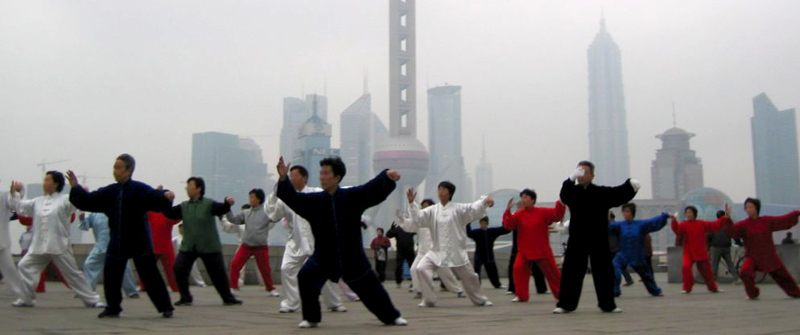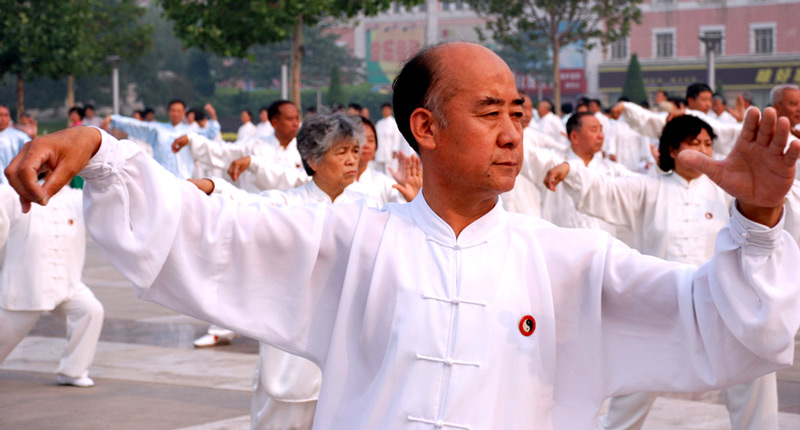Tai Chi in the Modern World

When Professor Zeng performs taijiquan, it looks textbook perfect. There's a simple reason for this. Professor Zeng wrote the book. He was one of the editors of China's 1988 taiji compilation, an influential treatise for the development of modern taijiquan. Professor Zeng Nailiang (曾乃梁) is one of the founding fathers of modern taijiquan.
But what is modern taijiquan? It's almost oxymoronic as taiji is an ancient art. When "modern" is bandied about in Chinese martial arts, one can't help but think of modern wushu. Although Professor Zeng stands among the greatest modern wushu coaches ever, his notion of modern taiji is not at all limited to contemporary competition wushu. Zeng is on a mission to spread taiji around the world, not just to wushu athletes.
In Western pop culture, taiji is bunched with yoga as a new-age alternative health regimen. Yoga has firmly secured itself as a fixture in health clubs,
especially fashionable with the female demographic. Meanwhile, taiji has been quietly stepping into hospitals, physical therapy clinics and senior
centers as a low-stress form of exercise. In this way, just like its yin nature, taiji has crept into America quietly like shadows growing at dusk.
The American view of martial arts is still very limited. When it comes to martial arts, America likes it yang. MMA has usurped the spotlight, and
that's about as yang as martial arts gets. Taiji won't help you one bit in the cage. But once the average practitioner outgrows the tattooed fighters
and the bikinied ring girls, MMA is impractical as a lifelong practice. Granny will never learn how to sprawl and deliver a rear naked choke. Our youth-driven
culture doesn't consider martial arts as a form of recuperative therapy or a practice for the elderly and invalids, but there lies its greatest power.
When it gets right down to it, it is this community that needs martial arts the most. Weaker individuals need martial arts, not just for self-defense
but for general health maintenance. Facing a trained fighter is one thing. Only a select few will ever step into the cage. Fighting off the challenge
of aging is another thing entirely. Most everyone will face the pitfalls of their autumn years.

Despite all the media attention, there are far more taiji practitioners than MMA practitioners. They just aren't as conspicuous. Taiji is the most practiced
martial art in the world today. When you add up all those grassroots practitioners in the hospitals and senior centers (a growing demographic as life
expectancy increases and medical costs rise), then include all the students in adult education and junior college classes (as taiji is offered in almost
every upper school catalog), plus factor in the millions of Chinese who practice it daily, the total sum of taiji practitioners may well be greater
than all the other martial arts combined.
At age 70, Professor Zeng remains an inspiration. He travels the world, sharing his taiji knowledge freely and joyfully, propounding the taiji way.
"To teach," quips Zeng in Mandarin, "you must have a passion for the arts." As taiji expands westward, it faces plenty of cross-cultural challenges.
Most westerners only know martial arts by the media images: fighting in the cage, in the movies or on the street. In the East, martial arts are cultivated
as an art and a discipline. It isn't just about results. Winning belts and starring in films are only for the top exponents. It's not only about surviving
a street fight. How many street fights do you get into exactly? If the number is high, you should reconsider your life. Martial arts are about personal
refinement.
"Taiji is a martial art," states Zeng emphatically, "but it also has health benefits. It's good for social exchange and a great preventative. Most people practice now for health. They still want some combat skills. We cannot omit the combat applications. If you take out the combat, it's more like dance or gymnastics. But in modern times, performance and health are on the rise and combat declines." Being form-based, taiji doesn't break up into easily-digestible components for classes like most other health club fitness programs like aerobics, weight training or even yoga. Taiji must be studied from beginning to end. While there have been some reformations to simplify taiji, it still takes time. There are no shortcuts. The word "cultivation" comes from farming. It takes time to till the land and produce a harvest. From fast food to Twitter, American culture is speed-oriented. Time is a commodity in short supply, so who has the time to practice taiji?
Culture follows fad, and over the last several decades different styles of martial arts have come in and out of fashion. Many wonder how much longer MMA will retain the spotlight. It's clearly here to stay, but will it remain the most popular expression of martial arts in the ever-fickle public eye? Or might the popularity pendulum swing in the other direction, towards the yin, towards taiji? For Professor Zeng, the slow and steady rise of taiji corresponds to its intrinsic nature. Taiji skill comes gradually over time. It's a quiet, reflective art that treads softly in the shadows, foregoing the spotlight of today in hopes of a brighter tomorrow.
(Extracts from an article "Putting Balls in to Tai Chi" by Gene Ching with Gigi Oh - Kung Fu Tai Chi Magazine March/ April 2012)
Recent Posts
- Caring for the Self
- Eight Energies, Five Steps, Two Weeks, and a Lifetime of Practice: Training at Beijing Sports University 2025
- Qigong: A Guide to Understanding the Many Paths of Energy Cultivation
- The Year of the Wood Snake and Tai Chi/Qigong: A Harmonious Interplay
- An Introduction to the Six Harmonies in Taijiquan
- Tai Chi Lessons from a Broken Piano: Work with What You Have
- Tai Chi and Cage Fighting: Zhang WeiLi, China’s UFC Champion
- Studio 14 - The Launch of a Dream
- It’s The Year of the Wood Dragon – A Great Time to Dream Big
- The 21st WTQA Festival 2023 - My First Wushu Tai Chi Qigong Festival
Tags
Archive
- December 2025 (1)
- November 2025 (1)
- March 2025 (1)
- January 2025 (1)
- November 2024 (1)
- September 2024 (1)
- July 2024 (1)
- January 2024 (2)
- December 2023 (1)
- September 2023 (1)
- June 2023 (2)
- April 2023 (1)
- January 2023 (2)
- November 2022 (1)
- August 2022 (1)
- March 2022 (1)
- January 2022 (2)
- September 2021 (1)
- May 2021 (1)
- March 2021 (1)
- February 2021 (2)
- January 2021 (1)
- December 2020 (1)
- August 2020 (1)
- April 2020 (1)
- January 2020 (1)
- October 2019 (1)
- May 2019 (2)
- April 2019 (1)
- March 2019 (3)
- February 2019 (2)
- January 2019 (3)
- December 2018 (2)
- October 2018 (1)
- July 2018 (1)
- June 2018 (1)
- April 2018 (2)
- February 2018 (1)
- October 2017 (1)
- September 2017 (1)
- April 2017 (2)
- March 2017 (1)
- January 2017 (2)
- December 2016 (2)
- October 2016 (1)
- September 2016 (1)
- August 2016 (1)
- July 2016 (2)
- June 2016 (21)
